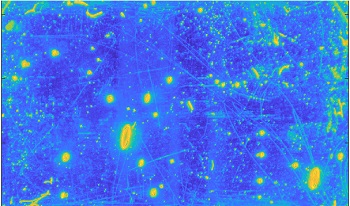
Reflectance Transformation Imaging (RTI) is a multi-light imaging technique using a camera on a fixed position and orthogonal to the studied surface, while varying the light position for each image captured. This allows for the reconstruction of a surface's visual appearance and the characterization of the surface by providing additional information on surface deformations and local micro-geometry. RTI was applied on historical model glass corroded in the presence of volatile organic compounds (VOCs) to visualize early stages of corrosion. RTI was used to create relighting visualizations and generate maps based on statistical descriptors derived from the local reflectance distribution of the pixels. Selected maps were able to assist in the quantification of corrosion signs i.e., fine cracks and salt neocrystallizations (SN), on a more global scale as compared to digital microscopy (DM). Therefore, RTI could provide an imaging solution for the characterization of corrosion signs on transparent colourless glass surfaces, which could not be visualized using simple RGB photography neither with transmitted nor reflected light.